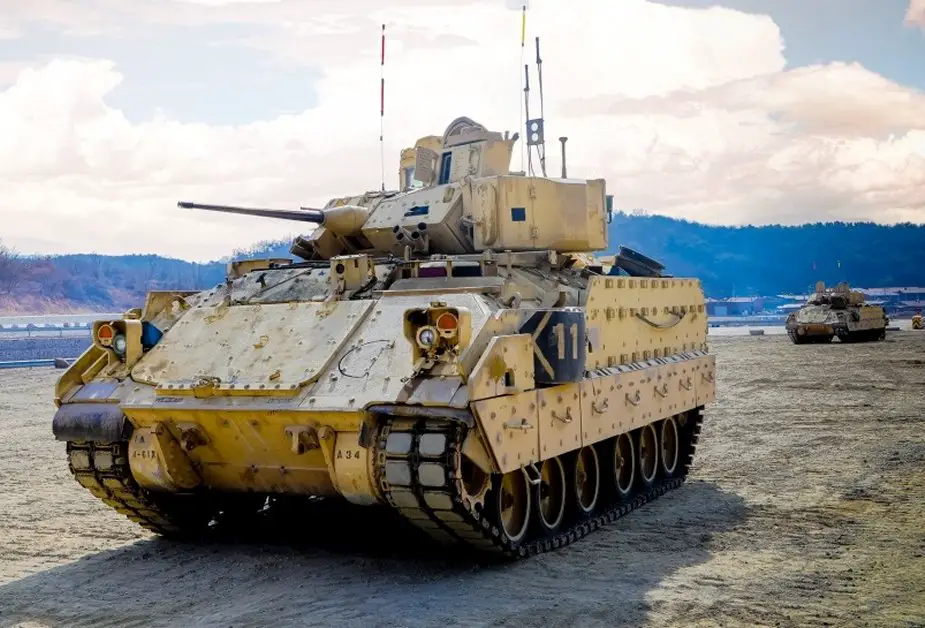Bradley Family of Vehicles (BFoV) Engineering Change Proposal (ECP) in the FY2019 Annual Report
Army Recognition looks back to a series of U.S. programs summarized in the FY2019 Annual Report for the Office of the Director, Operational Test & Evaluation. Hereunder, we have a glance at the Bradley Family of Vehicles (BFoV) Engineering Change Proposal (ECP).

M2A3 Bradley in South Korea (Picture source: U.S. Army/Sgt. Alon Humphrey, 3rd Armd Bde Combat Team, 1st Armd Div Public Affairs)
In 2019, the Army completed Phase I live fire testing of the Bradley Fighting Vehicle Systems (BFVS) Engineering Change Proposal (ECP) to evaluate the effect of these changes on the survivability of the Bradley to combat engagement‑induced ballistic shock and underbody accelerative loads. Preliminary analysis of Phase I live-fire testing did not reveal any significant or unexpected vulnerabilities. The Army is on schedule to complete the Phase II Full‑Up System-Level (FUSL) live-fire test events using a production‑representative Bradley vehicle in FY21. DOT&E will complete a detailed survivability analysis to support the Bradley A4 Early Fielding Decision in FY21.
System
The Bradley ECP program integrates new technologies to mitigate the degradation of existing system performance and maintains the operational capability outlined in current system requirements documents.
ECP Phase I included a suspension and track upgrade to restore ground clearance and suspension reliability because of increases in Bradley armor and weight.
ECP Phase II will upgrade the electrical system and power train to restore lost mobility, and integrate new technologies to improve situational awareness and vehicle survivability.
Completion of Phases I and II will result in the conversion of existing M2A3 and Operation Desert Storm – Situational Awareness (ODS-SA) versions of Bradley Fighting Vehicles into the M2A4 version, and the conversion of M7A3 Bradley Fire Support Team vehicle into the M7A4 version. The current
plan is to convert four brigades to the A4 variant and supply the European Deterrence Initiative with one brigade set of A4 vehicles.
The A4 versions will inherit the survivability enhancement features found on the A3/ODS-SA baseline configurations: Bradley Urban Survivability Kits, Bradley Reactive Armor Tiles, and Add-on Armor Kit that the Army developed and fielded in response to Operational Needs Statements during
Operation Iraqi Freedom. The A4 will also include the Commander’s Independent Viewer.
Mission
Combatant Commanders employ Armor Brigade Combat Teams equipped with Bradley Fighting Vehicles to provide protected transport of soldiers, provide direct fires to support dismounted infantry, to disrupt or destroy enemy military forces, and to control land areas.
Major Contractor
BAE Systems Land and Armaments – Sterling Heights, Michigan
Activity
The Army submitted an updated Test and Evaluation Master Plan with a comprehensive Phase I LFT&E Strategy that DOT&E approved in April 2016 with changes approved in December 2018.
The Army conducted all FY19 testing in accordance with the DOT&E-approved Test and Evaluation Master Plan and test plan.
The Bradley ECP LFT&E program consists of two phases:
* Phase I included system-level tests using prototype vehicles while Phase II will focus on FUSL events using production‑representative vehicles. The Army completed Phase I testing in FY19 and is scheduled to complete Phase II testing in FY21.
* Phase I live fire testing, performed from June 2018 to September 2018, included two shaped-charge jet test events, one thermobaric warhead test event, and two IED/mine engagement tests. Phase I also included Automatic Fire Extinguishing System testing performed from February to May 2019 to evaluate the effectiveness of the system to mitigate combat-induced fires.
Assessment
Preliminary analysis of Phase I live fire testing did not reveal any significant or unexpected vulnerabilities. In FY21, after the completion of Phase II live fire test series, DOT&E will finalize the Bradley A4 survivability assessment in support of its Early Fielding Decision. The assessment will consider Phase I and Phase II data as well as Bradley Reactive Armor Tiles tests completed in FY16, and modeling and simulation events.


























